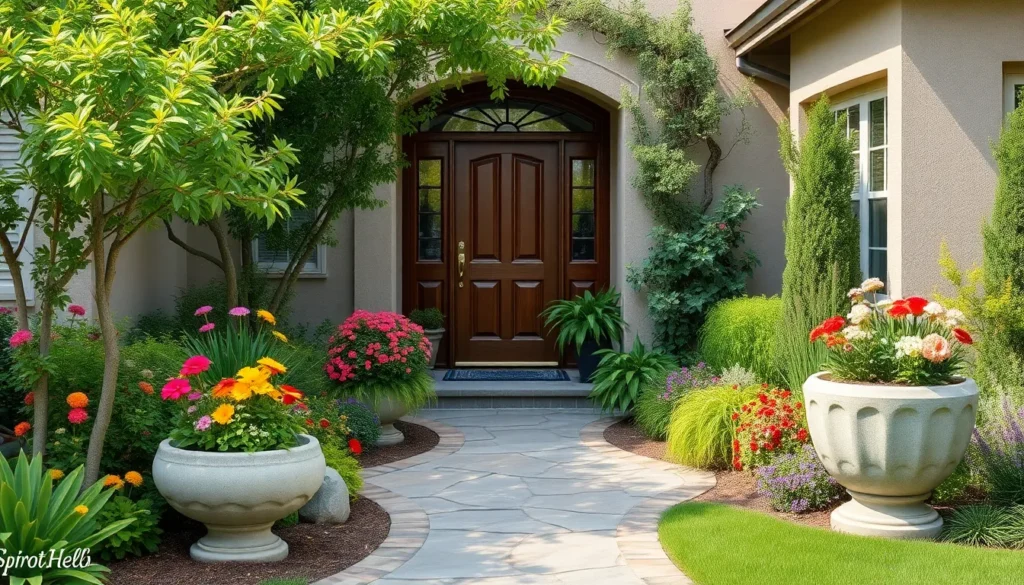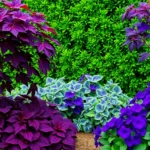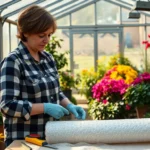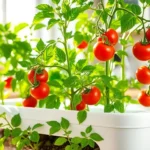Your home’s entrance garden sets the stage for every visitor who walks through your door. It’s the first impression that speaks volumes about your style and attention to detail. Whether you’re working with a sprawling front yard or a compact entryway we’ll show you how to transform your entrance into a stunning welcome statement.
Creating the perfect entrance garden doesn’t require a massive budget or years of landscaping experience. With the right plant selections strategic design elements and a few creative touches you can create an inviting space that enhances your home’s curb appeal and reflects your personality.
We’ve gathered the most inspiring entrance garden ideas that work for every style preference and space constraint. From modern minimalist designs to cottage-style abundance these proven concepts will help you create an entrance that makes guests stop and admire before they even reach your front door.
Create a Grand First Impression With Statement Planters
Statement planters serve as the foundation for creating an eye-catching entrance that welcomes visitors before they even reach your front door. Large, well-positioned containers can transform an ordinary entryway into a sophisticated focal point that reflects your home’s character.
Choose Oversized Containers for Maximum Impact
Oversized planters command attention and create visual weight that anchors your entrance design. We recommend selecting containers that measure at least 24 inches in diameter to achieve the dramatic effect you’re seeking. Large ceramic urns, weathered concrete planters, and substantial wooden barrels work exceptionally well for creating this bold statement.
Consider the scale of your entrance when choosing container sizes. Planters should complement your home’s proportions rather than overwhelm smaller spaces or disappear against larger facades. We’ve found that grouping containers of varying heights creates ever-changing visual interest while maintaining the impact of substantial sizing.
Material selection plays a crucial role in your planters’ longevity and aesthetic appeal. Stone and concrete containers offer durability and timeless elegance, while metal planters like copper or galvanized steel provide modern sophistication. Fiberglass options deliver the look of expensive materials at a fraction of the weight and cost.
Select Plants That Thrive in Your Climate Zone
Climate appropriate plants ensure your entrance garden maintains its beauty throughout the growing season without excessive maintenance. We always recommend consulting your USDA Hardiness Zone map before making plant selections to guarantee long-term success. Native plants typically require less water and care while providing natural beauty that complements your local environment.
Evergreen plants like boxwood, juniper, and holly provide year-round structure and color in your statement planters. These reliable performers maintain their appearance through seasonal changes and create a consistent backdrop for seasonal color additions. Ornamental grasses such as fountain grass and feather reed grass add texture and movement while tolerating various weather conditions.
Seasonal flowering plants can be rotated throughout the year to keep your entrance fresh and vibrant. Spring bulbs like tulips and daffodils, summer annuals like petunias and marigolds, and fall chrysanthemums allow you to change your entrance’s personality with each season. We suggest establishing a base of permanent plantings and adding seasonal elements for flexibility.
Arrange Planters Symmetrically for Formal Appeal
Symmetrical arrangements create a sense of order and elegance that enhances your home’s formal appearance. Placing matching planters on either side of your front door establishes balance and draws the eye toward your entrance. This classic approach works particularly well with traditional and colonial style homes.
Consider creating layers of symmetry by using different sized containers at varying distances from your door. Larger planters can flank the entrance while smaller matching containers line the walkway or steps. We recommend maintaining consistent plant selections across symmetrical arrangements to reinforce the formal design aesthetic.
Height variation within symmetrical layouts adds visual interest without sacrificing the orderly appearance. Tall, spiky plants like snake plants or dracaena in the center surrounded by trailing plants like ivy or sweet potato vine create dimension while maintaining balance. This approach allows each planter to make a statement while contributing to the overall formal composition.
Design a Welcoming Pathway Using Natural Materials
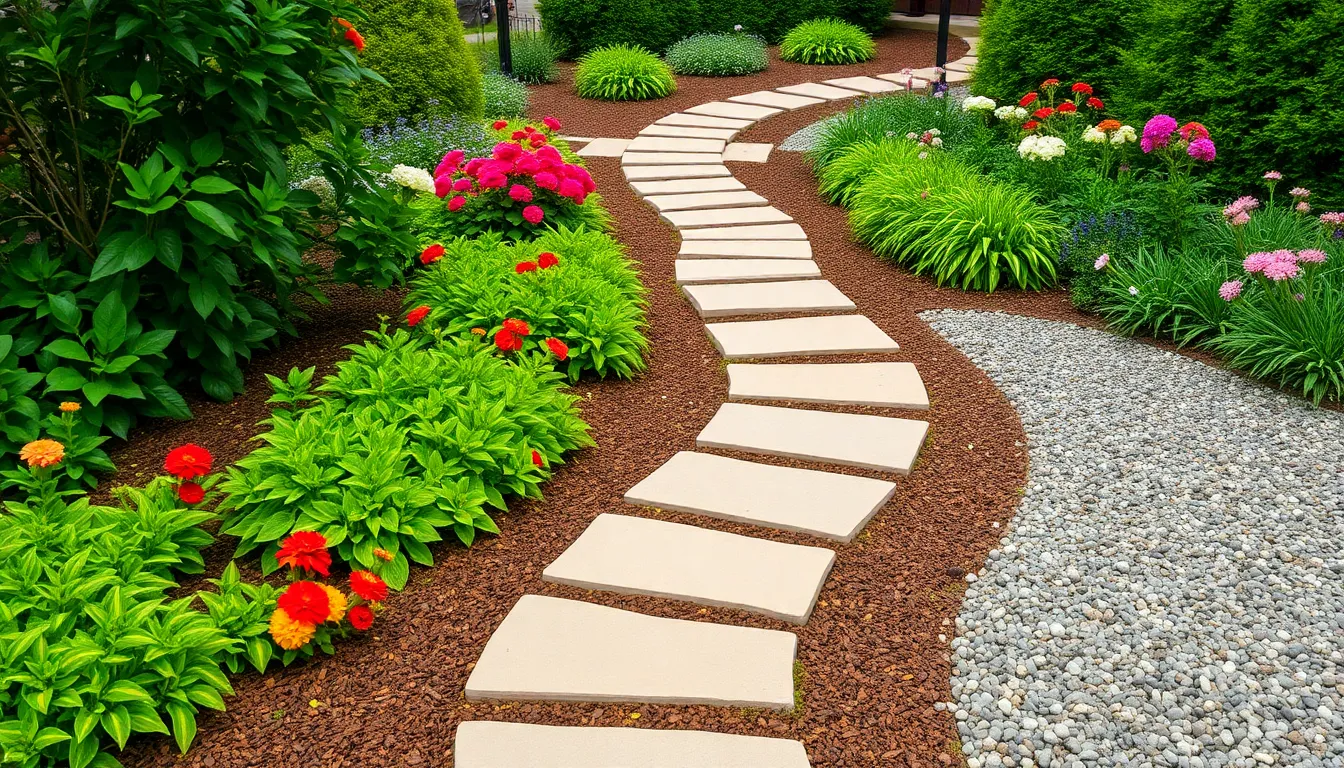
Natural materials create the foundation for entrance gardens that feel both sophisticated and inviting. These elements add warmth and character while establishing a seamless connection between your home and industry.
Install Flagstone or Brick for Timeless Elegance
Flagstone pathways offer unmatched durability and create a sophisticated look that complements various garden styles. The natural stone’s irregular patterns add organic beauty while providing a stable walking surface that can withstand heavy foot traffic and weather conditions for decades.
Brick pathways deliver classic charm and work exceptionally well with traditional home styles. We recommend using clay bricks in herringbone or basket weave patterns to create visual interest. The warm red and brown tones of brick naturally complement most plant colors and provide excellent contrast against green foliage.
Both materials require minimal maintenance once properly installed. Flagstone typically costs $15-25 per square foot installed, while brick ranges from $10-20 per square foot, making them cost effective long term investments for your entrance garden.
Add Gravel or Mulch Borders for Definition
Gravel borders create clean lines and help maintain pathway edges while preventing grass and weeds from encroaching. Decomposed granite or pea gravel work best for this purpose, providing excellent drainage and a neat appearance that requires minimal upkeep.
Mulch borders offer similar benefits while adding organic matter to the soil as they decompose. Cedar or pine bark mulch provides natural pest resistance, while cocoa hull mulch offers rich color and pleasant aroma. We suggest maintaining a 2-3 inch depth for optimal weed suppression.
These border materials also help with water management by directing rainfall away from walkways. The defined edges create visual separation between planted areas and pathways, making your entrance garden appear more intentional and professionally designed.
Incorporate Stepping Stones for Curved Walkways
Stepping stones work perfectly for curved walkways, offering a natural and inviting path through your entrance garden. Stone options include bluestone, limestone, and sandstone, each providing different textures and colors to match your home’s aesthetic.
Wood rounds from oak or cedar create rustic stepping stone alternatives that blend beautifully with cottage style gardens. These natural materials weather to attractive gray tones over time and can be replaced individually if needed.
Space stepping stones 18-24 inches apart for comfortable walking, and set them slightly above ground level to prevent water pooling. The irregular spacing and organic shapes of stepping stones encourage visitors to slow down and appreciate your garden’s details as they approach your entrance.
Frame Your Entrance With Seasonal Flower Displays
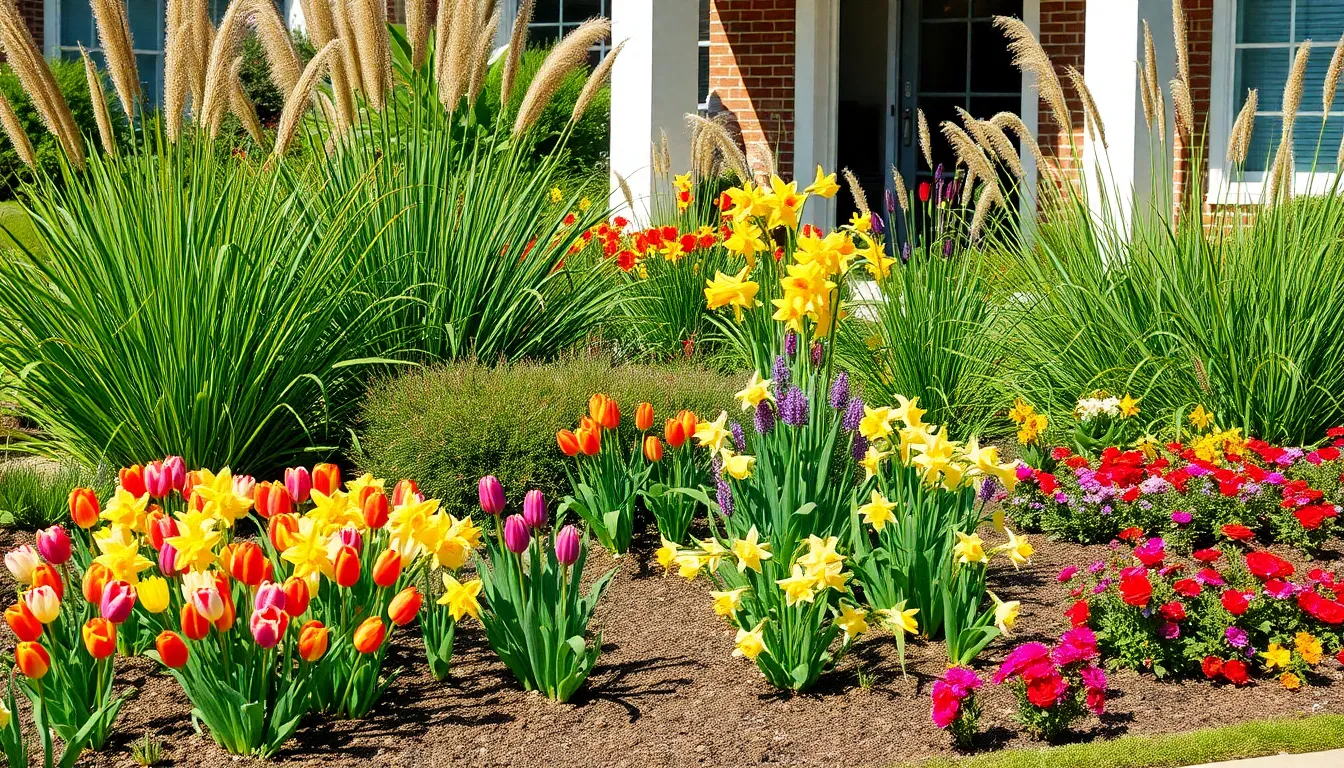
Creating stunning seasonal displays ensures your entrance garden maintains visual appeal throughout the year. We’ll explore strategic planting techniques that deliver continuous color from early spring through late fall.
Plant Spring Bulbs for Early Color Bursts
Spring bulbs transform your entrance after winter’s dormancy with vibrant early season color. Planting tulips, daffodils, and hyacinths in fall ensures spectacular blooms emerge as snow melts away, creating an immediate welcome for visitors.
Timing your bulb installation correctly maximizes their impact during spring’s arrival. We recommend planting these bulbs 6-8 weeks before your area’s first hard frost, allowing proper root development before winter dormancy sets in.
Spring perennials like Iris species complement bulb displays while providing lasting garden structure. These plants deliver perennial punch without consuming excessive space, making them perfect for entrance gardens where every square foot matters.
Ornamental grasses paired with spring bloomers create textural contrast that enhances visual interest. Their upright growth habit frames colorful bulb displays while establishing a foundation for your seasonal rotation strategy.
Choose Summer Annuals for Continuous Blooms
Summer annuals deliver vibrant colors throughout the growing season when properly selected for your climate. Coleus varieties provide stunning foliage colors ranging from deep burgundy to bright chartreuse, thriving in both sun and shade conditions.
Kangaroo paws offer exotic blooms that create conversation pieces in entrance displays. These unique flowering plants perform exceptionally well in containers, allowing easy repositioning as seasonal displays evolve.
Container plantings with summer annuals provide flexibility for changing displays as seasons progress. We suggest using large containers that accommodate root growth while providing visual weight proportional to your entrance scale.
Summer perennials like hyssops (Agastache rupestris) attract hummingbirds and butterflies to your entrance garden. These wildlife magnets add ever-changing movement and activity that creates captivating focal points for visitors approaching your home.
Select Fall Perennials for Extended Interest
Fall perennials extend your entrance garden’s appeal well beyond summer’s peak growing season. Shrubs with colorful berries like Ilex verticillata ‘Winter Gold’ provide striking visual interest during autumn and winter months.
These berry producing plants serve dual purposes by feeding wildlife while maintaining garden color. Birds visiting your entrance create additional movement and interest that enhances the overall garden experience for guests.
Dwarf flowering shrubs combined with maiden grass deliver easy care texture during fall transitions. These low maintenance options ensure your entrance remains polished without requiring intensive seasonal labor.
Fall textures become increasingly important as flower displays fade and deciduous plants prepare for dormancy. Strategic placement of textural elements maintains visual appeal even after peak growing seasons conclude.
Establish Height and Structure With Ornamental Trees
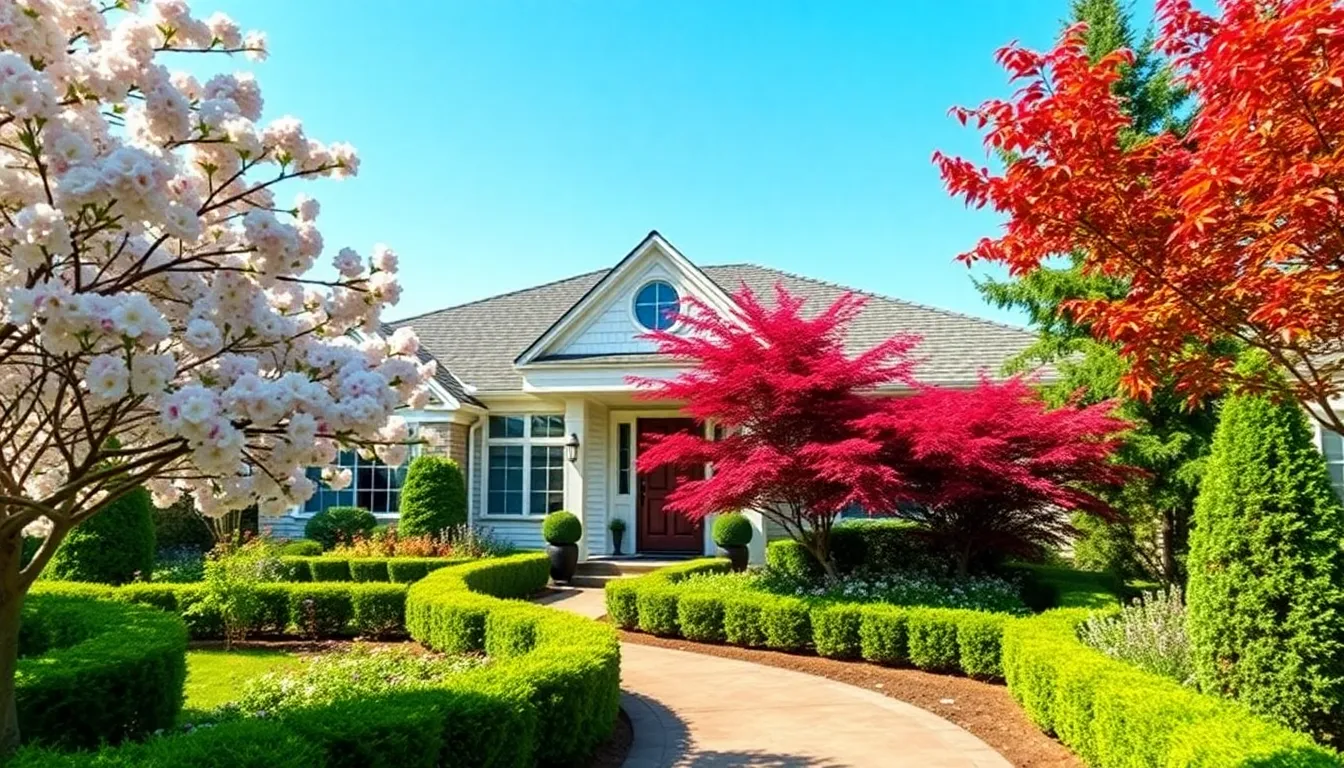
Ornamental trees serve as the backbone of entrance garden design, creating vertical interest and establishing the foundational structure that guides visitors toward your home. We’ll explore strategic approaches to selecting and positioning these essential elements for maximum visual impact.
Position Small Trees to Frame the Entrance
Strategic placement transforms small trees into living architectural elements that naturally draw attention to your front door. We recommend positioning dwarf varieties of flowering trees like cherry blossoms or ornamental Japanese maples on either side of your entrance pathway to create an elegant frame.
Dwarf flowering trees work exceptionally well because they won’t overwhelm smaller entrance spaces while still providing substantial visual presence. These compact varieties typically reach 8-12 feet at maturity, making them perfect for creating intimate entrance settings without blocking windows or architectural features.
Symmetrical positioning creates formal elegance, while asymmetrical arrangements offer a more relaxed, cottage garden feel. We suggest placing trees at least 8-10 feet from your home’s foundation to allow proper root development and prevent future structural issues.
Select Flowering Varieties for Seasonal Interest
Flowering trees extend your entrance garden’s appeal throughout multiple seasons by providing bursts of color at different times of the year. Cherry blossoms deliver spectacular spring displays with their delicate pink or white flowers, while dogwoods offer summer blooms in shades of white, pink, or red.
Crabapples provide exceptional seasonal progression with spring flowers followed by colorful fall fruit that attracts wildlife and adds autumn interest. These versatile trees come in varieties with different bloom times, allowing you to stagger flowering periods for extended visual impact.
Timing your selections strategically ensures continuous seasonal displays rather than brief flowering periods. We recommend choosing at least two different flowering varieties that bloom in separate seasons to maintain year round visual interest in your entrance garden.
Consider Evergreens for Year-Round Appeal
Evergreen trees provide consistent structure that anchors your entrance garden design through all seasons, maintaining their foliage when deciduous plants go dormant. Arborvitae varieties offer excellent screening potential while creating formal, upright architectural elements.
Boxwood shrubs deliver versatility in entrance garden applications, responding well to pruning and shaping while maintaining dense, year round foliage. These reliable evergreens work particularly well for creating defined borders or geometric shapes in formal entrance designs.
Holly varieties combine function with beauty by providing evergreen structure plus seasonal berries that add winter color and wildlife value. We suggest selecting female holly varieties paired with male pollinators to ensure berry production that extends visual interest through the dormant season.
Add Architectural Interest With Garden Sculptures
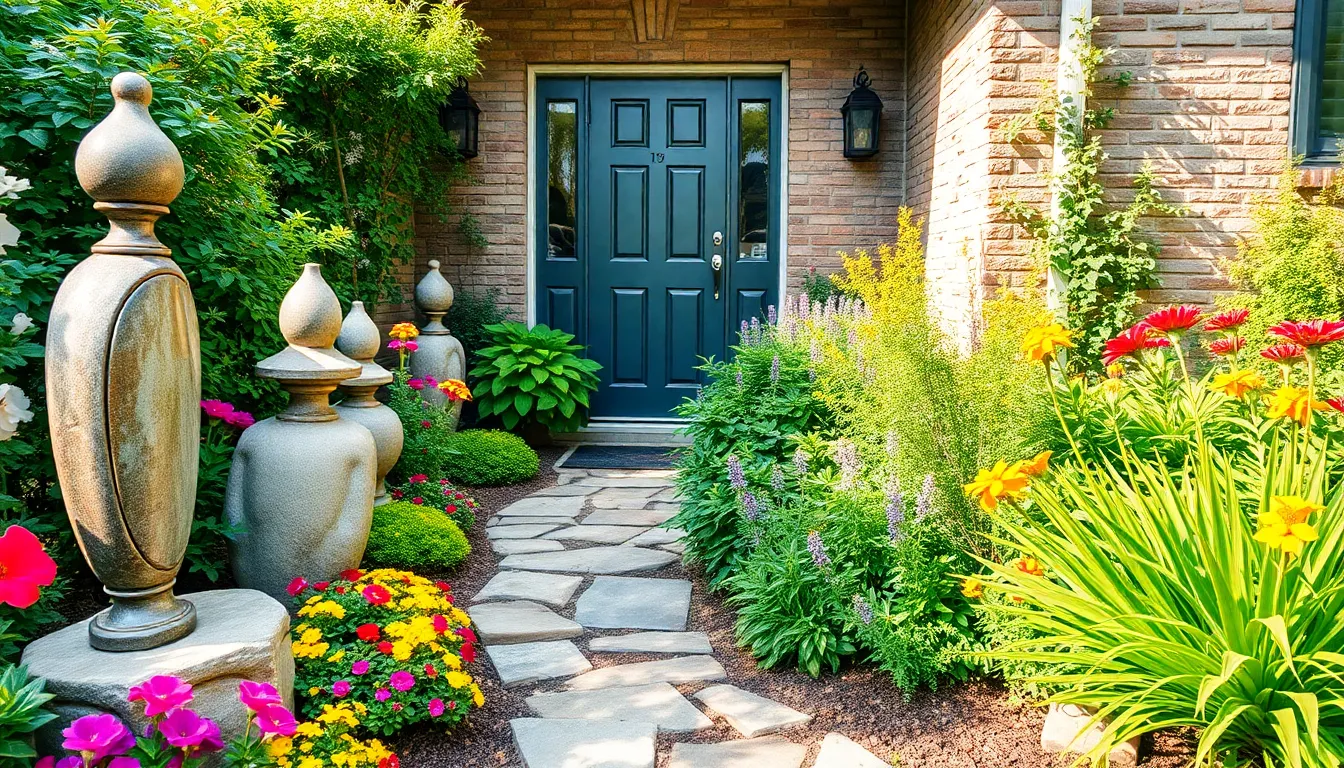
Garden sculptures transform ordinary entrance spaces into memorable first impressions that reflect our personal style. These artistic elements create focal points that draw visitors’ attention while adding unique character to our outdoor welcome areas.
Choose Weather-Resistant Materials and Finishes
Durable materials ensure our sculptural investments withstand harsh outdoor conditions year after year. Stone sculptures like granite and marble resist weathering naturally, while metal pieces crafted from bronze, aluminum, or powder-coated steel maintain their appearance through rain, snow, and intense sunlight. Fiberglass and resin sculptures offer lightweight alternatives that won’t crack in freezing temperatures or fade under UV exposure.
Weather-resistant finishes protect our decorative elements from environmental damage. Marine-grade sealers shield stone and concrete pieces from moisture penetration, while rust-inhibiting primers prevent metal corrosion. UV-stable paints maintain vibrant colors on handmade sculptures and painted pebbles without chalking or peeling over time.
Mosaic art requires specialized weatherproofing techniques to preserve intricate designs. Sealed grout lines prevent water infiltration that causes tiles to loosen, while frost-resistant adhesives keep decorative elements securely attached through temperature fluctuations.
Scale Pieces Appropriately to Your Space
Properly sized sculptures create visual harmony without overwhelming our entrance garden’s proportions. Large gardens accommodate statement pieces measuring 3-4 feet in height, while compact spaces benefit from smaller sculptures ranging 18-24 inches tall. Medium-sized properties work best with graduated arrangements featuring one prominent piece surrounded by smaller complementary elements.
Oversized sculptures dominate small entrance areas and block natural sight lines to our front door. These massive pieces create visual barriers that make narrow pathways feel cramped and unwelcoming. Instead, we choose proportionate elements that enhance rather than compete with our home’s architecture.
Undersized pieces disappear among larger industry elements and fail to create intended focal points. Tiny sculptures get lost beside mature plantings or substantial planters, reducing their visual impact. We select pieces substantial enough to hold their own against surrounding garden features while maintaining appropriate scale relationships.
Position Art to Guide Visitors Toward the Door
Strategic sculpture placement creates a natural flow that leads guests along our entrance pathway. We position larger pieces at pathway curves or decision points where visitors might hesitate, using them as directional markers that maintain forward momentum. Smaller sculptures work effectively when clustered at regular intervals, creating visual stepping stones that guide movement.
Inviting arbors serve as gateway markers that signal the beginning of our entrance journey. These architectural elements frame views toward our front door while providing vertical interest that draws the eye upward and forward. Painted or carved details on arbor posts add personality without distracting from their wayfinding function.
Handmade sculptures positioned asymmetrically create visual tension that encourages exploration. Rather than centering pieces directly in front of our door, we place them slightly off-axis to create gentle curves in our visitors’ approach path. This technique builds anticipation and engagement as guests discover new viewing angles while walking toward our entrance.
Illuminate Your Garden for Evening Curb Appeal
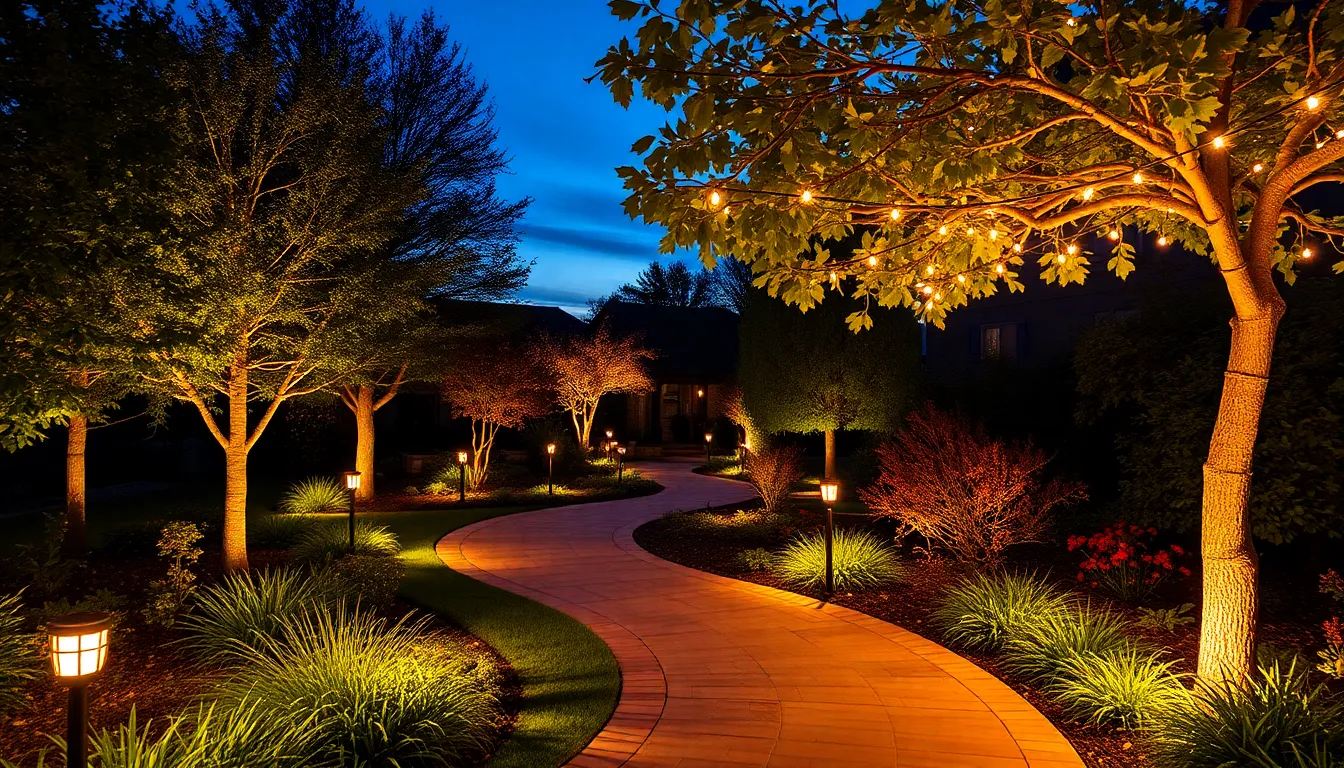
Well-lit entrance gardens create positive first impressions while improving security and visibility for your home. Combining pathway, landscaping, and entryway lighting fixtures effectively highlights architectural features and showcases your carefully selected plants.
Install Solar-Powered Path Lights for Sustainability
Solar-powered lights offer an environmentally friendly solution that requires no wiring or electrical connections. Installing these fixtures becomes effortless since they simply stake into the ground along your walkway. These sustainable options help reduce electricity usage while providing adequate illumination for safe navigation during evening hours.
Solar path lights work exceptionally well for most residential settings, though they may not produce the same brightness as wired alternatives. Weather conditions and seasonal sunlight variations can affect their performance, but modern solar technology has significantly improved reliability and light output.
Use Uplighting to Highlight Key Plants and Features
Uplighting techniques direct light upward to accentuate trees, shrubs, and distinctive garden features throughout your entrance space. This strategic lighting method adds depth and dimension while creating dramatic shadows that enhance the visual appeal of your industry after dark.
LED floodlights and spotlights serve as the primary fixtures for uplighting applications, offering both flexibility and energy efficiency. Positioning these lights at the base of ornamental trees like Japanese maples or flowering cherry trees creates stunning silhouettes against your home’s exterior walls.
Tree trunks, sculptural elements, and textural plantings become focal points when properly illuminated from below. Strategic placement of uplighting fixtures also helps define garden borders and creates visual continuity throughout your entrance design.
Add String Lights for Warm Ambient Lighting
String lights create cozy, inviting atmospheres that welcome visitors with their soft, warm glow. Draping these versatile fixtures along fences, wrapping them around tree branches, or hanging them above walkways adds a magical quality to evening garden experiences.
Both solar-powered and plug-in options provide installation flexibility depending on your exact needs and power availability. Solar string lights eliminate the need for outdoor electrical outlets while plug-in versions offer consistent brightness throughout the night.
Layering string lights with other lighting types creates depth and visual interest in your entrance garden design. Combining ambient string lighting with focused pathway illumination and dramatic uplighting produces a comprehensive lighting scheme that enhances both safety and aesthetic appeal.
Create Privacy and Boundaries With Living Screens
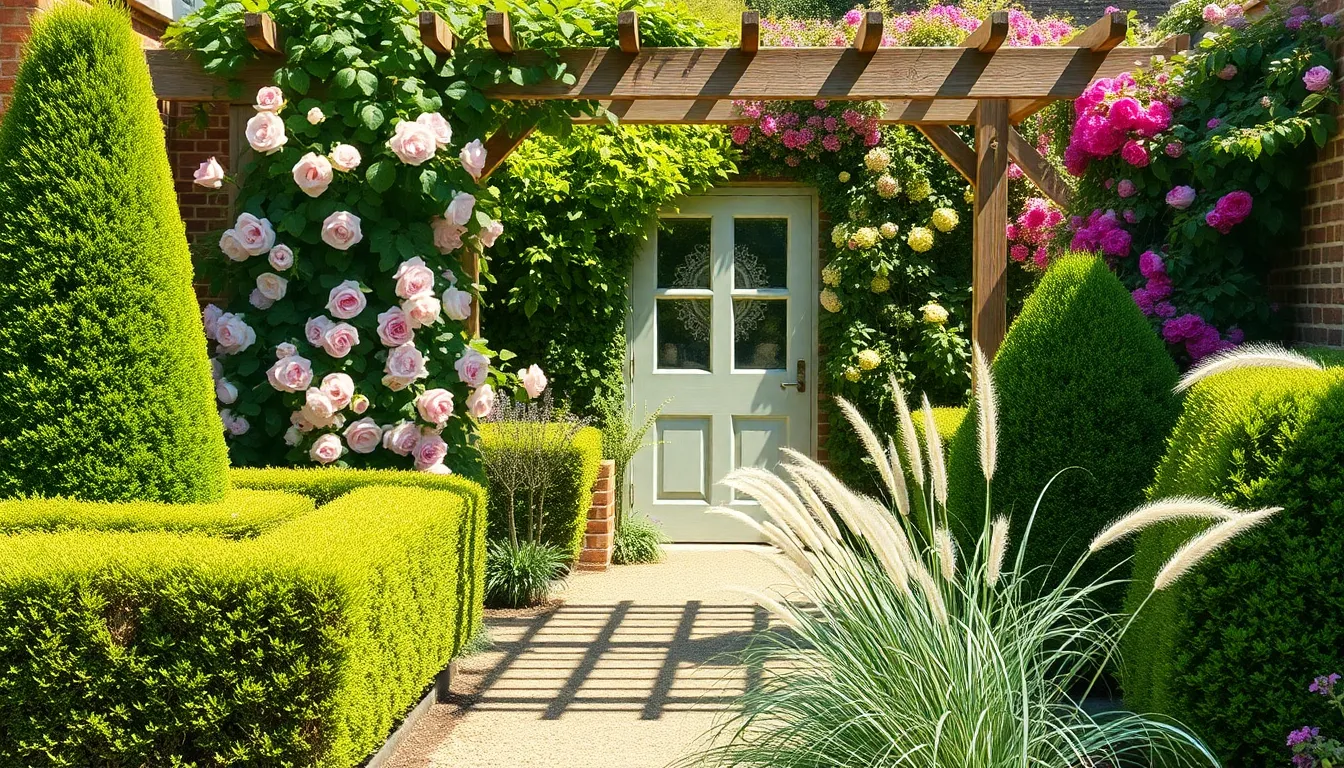
Living screens offer an elegant solution for defining your entrance garden while maintaining an open, welcoming atmosphere. These natural barriers provide structure and intimacy without the harsh appearance of traditional fencing.
Plant Hedges for Natural Property Lines
Hedges create stunning natural boundaries that enhance your property’s visual appeal while establishing clear property lines. Boxwood hedges offer timeless elegance with their dense, evergreen foliage that maintains structure throughout all seasons. Yew varieties provide excellent durability and can withstand regular pruning to maintain desired shapes and heights.
Privet hedges grow quickly and create dense screening, making them ideal for homeowners seeking immediate privacy results. These versatile plants adapt to various soil conditions and climate zones across the United States. Regular maintenance keeps hedge lines crisp and professional looking, typically requiring trimming twice per year during growing seasons.
Consider the mature height and width of your chosen hedge species when planning spacing and placement. Most hedge plants require 2 to 4 feet between individual plants for proper growth and coverage. Plant hedges at least 3 feet from property lines to allow adequate growing space and avoid future neighbor disputes.
Install Trellises With Climbing Vines
Trellises with climbing vines transform vertical spaces into beautiful living screens that add height and visual interest to entrance gardens. Rose varieties like climbing roses or rambling roses create romantic, fragrant displays that bloom throughout growing seasons. Clematis vines offer diverse flower colors and bloom times, allowing you to select varieties that complement your overall garden color scheme.
Install sturdy trellises that can support the mature weight of fully grown vines, typically requiring posts anchored at least 2 feet deep. Cedar and metal trellises provide long lasting durability against weather conditions, while wooden options offer natural aesthetics that blend seamlessly with garden environments.
Position trellises 6 to 12 inches away from walls or fences to allow adequate air circulation around climbing plants. This spacing prevents moisture buildup that can lead to plant diseases and structural damage. Train young vines by gently tying growth to trellis supports using soft plant ties or twine.
Use Ornamental Grasses for Soft Screening
Ornamental grasses provide gentle, natural screening that moves gracefully with breezes while adding texture and seasonal interest to entrance gardens. These versatile plants create soft barriers without completely blocking views, maintaining an open feel while defining garden spaces.
Fountain grass varieties offer elegant arching forms with feathery plumes that catch light beautifully during golden hour lighting. Miscanthus grasses grow tall enough to provide substantial screening while producing attractive seed heads that persist through winter months. Pampas grass creates dramatic focal points with its large, showy plumes, though it requires adequate space due to its substantial mature size.
Plant ornamental grasses in clusters of odd numbers for natural looking groupings that create visual impact. Space individual plants according to their mature spread, typically 3 to 6 feet apart depending on the variety. Most ornamental grasses thrive in full sun locations with well draining soil conditions.
Cut back deciduous ornamental grasses in late winter or early spring before new growth begins. Leave evergreen varieties untrimmed to maintain year round structure and visual interest in your entrance garden design.
Incorporate Water Features for Soothing Sounds
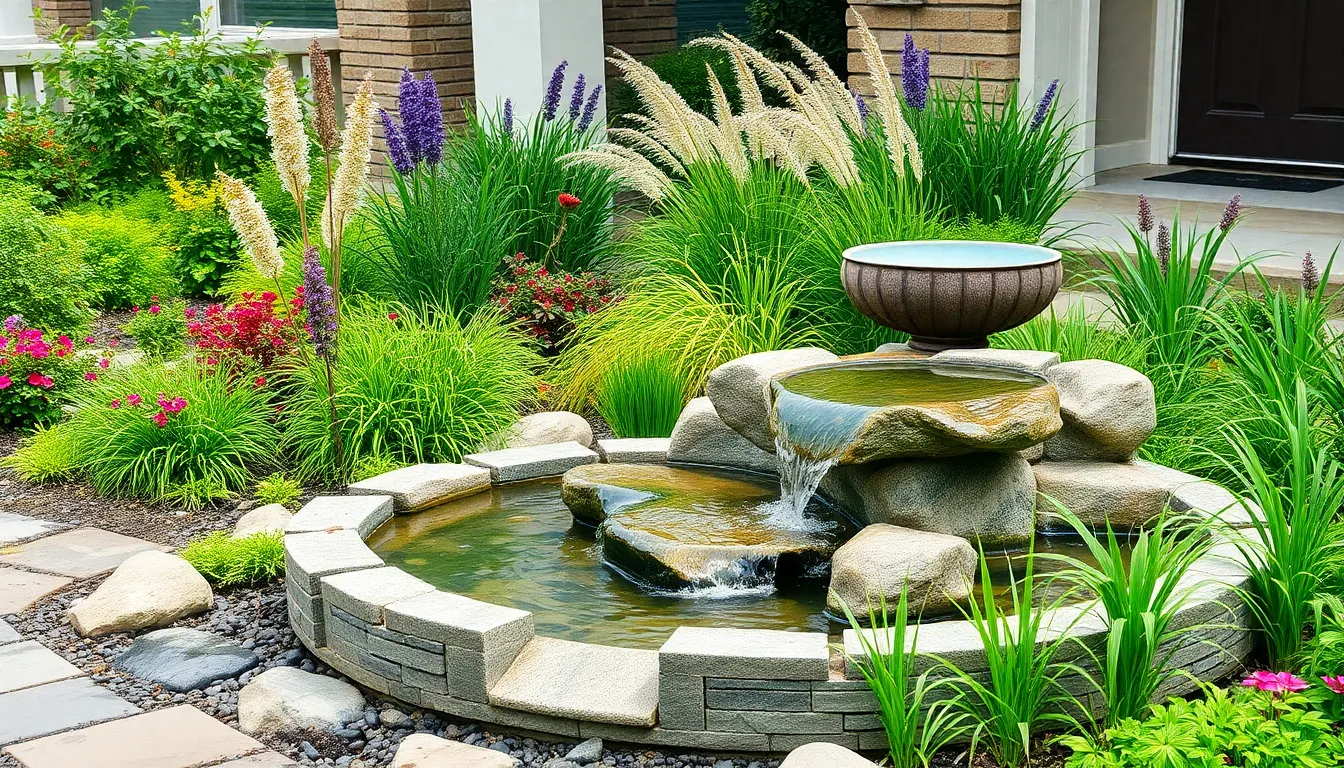
Water elements transform entrance gardens into tranquil spaces that greet visitors with calming sounds and visual beauty. These features complement your existing lighting and sculptural elements while adding a ever-changing layer to your garden design.
Install a Small Fountain as a Focal Point
Fountains serve as vibrant centerpieces that provide both soothing sounds and visual appeal to entrance gardens. We recommend selecting fountains that fit various garden styles, from modern to traditional designs, ensuring they harmonize with your overall aesthetic vision.
Position your fountain where it naturally draws the eye without overwhelming other design elements. The gentle sound of flowing water creates a welcoming atmosphere that masks street noise and sets a serene tone for visitors approaching your home.
Choose fountains with recirculating pumps to maintain water quality and reduce maintenance requirements. Modern options include solar-powered models that eliminate the need for electrical connections while providing sustainable operation throughout the day.
Add a Bubbling Rock for Subtle Movement
Bubbling rocks offer a subtle yet effective way to introduce movement and gentle sounds into your entrance garden. These natural-looking features create quiet ambiance that enhances the serenity of your space without dominating the industry design.
Install your bubbling rock among existing plantings where it appears as a natural element rather than an obvious addition. The water emerges from the rock’s surface and trickles down into a hidden reservoir, creating continuous movement that attracts birds and beneficial wildlife.
Maintenance remains minimal with bubbling rocks since they require only periodic water refilling and occasional cleaning. Their understated presence works particularly well with ornamental grasses and perennial plantings that we’ve discussed in previous sections.
Consider a Rain Chain for Functional Beauty
Rain chains replace traditional downspouts with decorative elements that guide rainwater into collection areas while creating musical sounds. We find these functional features add vertical interest to entrance gardens while serving a practical purpose during rainfall.
Connect your rain chain to existing gutters and direct the water flow into a decorative basin or small pond at ground level. The chain creates a gentle tinkling sound as water travels down each link, transforming ordinary rain into a garden symphony.
Choose materials like copper or stainless steel that develop attractive patinas over time while maintaining structural integrity. Rain chains work especially well when positioned near pathways where visitors can appreciate both their visual appeal and soothing sounds during weather events.
Conclusion
Your entrance garden sets the stage for every visitor’s experience and we’ve shown you how simple elements can create extraordinary impact. From statement planters and natural pathways to seasonal displays and architectural features each component works together to welcome guests while reflecting your personal style.
The beauty of entrance garden design lies in its flexibility – you can start small with a few well-placed containers or transform your entire front industry. Remember that successful entrance gardens evolve with the seasons and your changing preferences.
We encourage you to experiment with different combinations of plants lighting and decorative elements until you find the perfect balance for your space. Your entrance garden should feel authentically yours while creating that crucial positive first impression that makes every homecoming feel special.
Frequently Asked Questions
What is the main purpose of an entrance garden?
An entrance garden creates a strong first impression for visitors to your home and enhances curb appeal. It serves as a welcoming space that showcases your personality and style while adding value to your property. A well-designed entrance garden doesn’t require extensive landscaping experience or a large budget to be effective.
What size should statement planters be for maximum impact?
Statement planters should be at least 24 inches in diameter to create a bold, eye-catching impact at your entrance. Oversized containers make more of a visual statement than smaller ones and provide adequate space for plant growth. Choose durable materials like stone, concrete, metal, or fiberglass for longevity.
Which materials work best for creating entrance pathways?
Flagstone and brick are excellent choices for entrance pathways due to their durability and timeless elegance. These natural materials add sophistication and warmth to your entrance garden. Gravel and mulch borders help define pathways and manage water drainage, while stepping stones work well for curved walkways.
How can I maintain year-round color in my entrance garden?
Plant spring bulbs like tulips and daffodils in fall for vibrant early color. Use summer annuals like coleus for continuous blooms, and incorporate fall perennials with colorful berries. Mix evergreen plants with seasonal flowers, and add ornamental grasses for texture and structure throughout all seasons.
What types of trees work best for entrance gardens?
Small flowering trees like cherry blossoms and ornamental Japanese maples frame entrances beautifully without overwhelming smaller spaces. Evergreens like arborvitae and boxwood provide year-round structure and appeal. Combining flowering and evergreen varieties ensures visual interest throughout all seasons while maintaining proper scale.
How should I incorporate garden sculptures effectively?
Choose weather-resistant materials like stone, metal, fiberglass, or resin for durability. Size sculptures appropriately for your space – large pieces for bigger gardens, medium for moderate spaces, and small accents for compact areas. Place sculptures strategically to guide visitors toward your door and create natural flow.
What lighting options work best for entrance gardens?
Solar-powered path lights provide sustainable, easy-to-install illumination for safety and ambiance. Use uplighting techniques to highlight key plants and architectural features. String lights add warm, inviting atmosphere with both solar and plug-in options available. Layer different lighting types for comprehensive coverage.
How can I create privacy without blocking my entrance?
Use hedges like boxwood and privet to establish natural property lines while maintaining visual appeal. Install trellises with climbing vines such as roses and clematis for vertical interest. Ornamental grasses provide soft screening that creates gentle barriers while preserving an open, welcoming atmosphere.
What water features work well in entrance gardens?
Small fountains serve as excellent focal points, providing soothing sounds and visual appeal. Bubbling rocks offer subtle movement and gentle ambiance without overwhelming the space. Rain chains combine functionality with decoration, guiding rainwater while creating pleasant musical sounds during rainfall.

